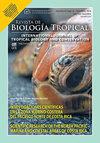印度尼西亚环环山自然保护区无刺蜜蜂巢的位置和特征
IF 0.6
4区 生物学
Q4 BIOLOGY
引用次数: 0
摘要
简介:无刺蜜蜂广泛分布在热带和亚热带地区。在印度尼西亚,无刺蜜蜂的分布分为三个地区,即印度-马来亚、瓦拉几亚和印度-澳大利亚。巴布亚已经记录了十种无刺蜜蜂,其中七种是当地特有的。独眼山自然保护区(CMNR)是印度尼西亚巴布亚的动植物保护区之一。不幸的是,对巴布亚无刺蜜蜂多样性的研究有限。目的:了解无刺蜜蜂的多样性、筑巢地点、入巢特征和巢结构。方法:分别采用道路采样法和当地居民资料对自然保护区和居民区的无刺蜂巢进行观察。共研究了22个菌落。结果:发现了两种无刺蜂,即智齿蜂(Cockerell,1911)和扁齿蜂(Platytrigona)(Smith,1865)。目前的研究显示,智齿龙和扁齿龙在CMNR中有新的分布记录。智人的筑巢地点通常在房屋地基中,而扁牙龙的筑巢地点则在椰子树的洞穴中。智人的巢穴入口多种多样,即椭圆形、椭圆形、圆形、不规则、水平或垂直伸长。同时,扁穗海雀的巢口在垂直方向上被拉长。智人的孵化细胞各不相同,即垂直、水平或半簇,而扁耳草的孵化细胞呈垂直分层。结论:发现的两种无刺蜂,智蜂和扁蜂,有新的分布记录,智蜂是巴布亚的优势种。该物种的巢穴入口在形状、颜色和质地上各不相同。本文章由计算机程序翻译,如有差异,请以英文原文为准。
Location and characteristics of stingless bee nests (Apidae: Meliponini) in the Cycloop Mountain Nature Reserve, Indonesia
Introduction: Stingless bees are widespread in tropical and subtropical regions. In Indonesia, the distribution of stingless bees are grouped in three regions, namely Indo-Malayan, Wallacea, and Indo-Australian. Ten species of stingless bees have been recorded in Papua, seven of which are endemic. The Cycloop Mountains Nature Reserve (CMNR) is one of the conservation area in Papua, Indonesia, for flora and fauna. Unfortunately, the study of the diversity of stingless bees in Papua has been limited. Objective: To measure the diversity, nesting sites, nest entrance characteristics and nest architecture of stingless bees. Methods: Observation of the stingless bee nests in the nature reserves and in the residential areas used a road sampling method and information from local people, respectively. A total of 22 colonies were studied. Results: Two species of stingless bee were found, namely Tetragonula sapiens (Cockerell, 1911) and Heterotrigona (Platytrigona) planifrons (Smith, 1865). The current study showed new distribution records for T. sapiens and H. planifrons in the CMNR. The nesting site of T. sapiens was commonly found in house foundation, while that of H. planifrons was in coconut palm cavities. The nest entrance of T. sapiens varied, i.e., elliptical, oval, rounded, irregular, horizontally or vertically elongated. Meanwhile, the nest entrance of H. planifrons was vertically elongated. The brood cells of T. sapiens varied, i.e., vertical, horizontal, or semi-clusters, while in H. planifrons was layered vertically. Conclusions: Two species of stingless bees found, T. sapiens and H. planifrons, showed a new distribution records and T. sapiens was a dominant species in Papua. The nest entrance of the species varied in shape, color, and texture.
求助全文
通过发布文献求助,成功后即可免费获取论文全文。
去求助
来源期刊

Revista De Biologia Tropical
生物-生物学
CiteScore
1.80
自引率
0.00%
发文量
23
审稿时长
4-8 weeks
期刊介绍:
The Revista de Biología Tropical / International Journal of Tropical Biology and Conservation is a mainstream scientific journal published since 1953 and covered by Web of Science; Science Citation Index; Current Contents; Google Scholar; Scopus, SciELO and nearly 50 additional indices.
A double blind system guarantees you a fair evaluation, and our world class editorial and scientific boards provides a first decision in three working days. The journal is Full Open Access and is widely read where your article can have the highest real impact.
Since its beginning in 1953, the Revista follows these principles: objective and independent evaluation of all manuscripts; transparency in all processes; ethical use of procedures, data, specimens and subjects; fair treatment of all parties; and absolute predominance of scientific rigor over any other aspect.
 求助内容:
求助内容: 应助结果提醒方式:
应助结果提醒方式:


